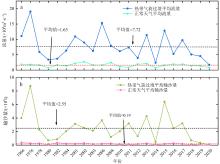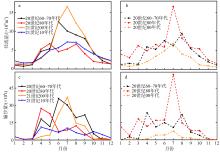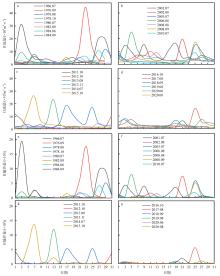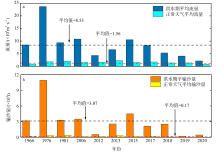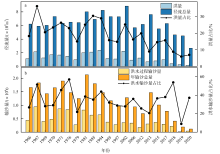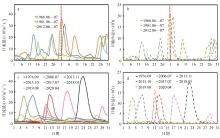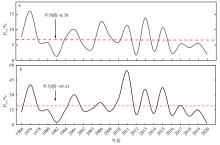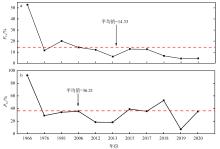Journal of Tropical Oceanography ›› 2023, Vol. 42 ›› Issue (4): 91-103.doi: 10.11978/2022176CSTR: 32234.14.2022176
Special Issue: 全球变化专题
• Marine Hydrology • Previous Articles Next Articles
Variations in water and sediments of the Nanliu River flowing into the sea under the influence of extreme weather in the past 60 years
YANG Xialing1( ), LI Shushi2(
), LI Shushi2( ), XU Shanshan1, YU Chongxi3, PAN Jie3
), XU Shanshan1, YU Chongxi3, PAN Jie3
- 1. School of Geography and Planning, Nanning Normal University, Nanning 530100, China
2. Guangxi Key Laboratory of Marine Environment Change and Disaster in Beibu Gulf (Beibu Gulf University), Qinzhou 535011, China
3. College of Resources and Environment, Beibu Gulf University, Qinzhou 535011, China
-
Received:2022-08-13Revised:2022-10-19Online:2023-07-10Published:2022-10-14 -
Supported by:Guangxi Natural Science Foundation Key Fund(2018JJD150005); National Natural Science Foundation of China(41866001); Guangxi First-class Discipline of Marine Science, Beibu Gulf University(DRB006); Guangxi First-class Discipline of Marine Science, Beibu Gulf University(DTC003); Innovation and Entrepreneurship Training Program for Undergraduates of Beibu Gulf University(202011607021); Innovation and Entrepreneurship Training Program for Undergraduates of Beibu Gulf University(S202111607128)
Cite this article
YANG Xialing, LI Shushi, XU Shanshan, YU Chongxi, PAN Jie. Variations in water and sediments of the Nanliu River flowing into the sea under the influence of extreme weather in the past 60 years[J].Journal of Tropical Oceanography, 2023, 42(4): 91-103.
share this article
Add to citation manager EndNote|Reference Manager|ProCite|BibTeX|RefWorks
Tab. 1
Statistics of tropical cyclone data and flood data in Nanliu River from 1966 to 2020"
| 极端天气类型 | 年份 |
|---|---|
| 热带气旋年 | 1966、1976、1978、1980、1982、1984、2001、2002、2003、2006、2008、2010、 |
| 2011、2012、2013、2014、2015、2016、2017、2018、2019、2020 | |
| 洪水年 | 1966、1967、1969、1970、1971、1976、1979、1981、1985、1994、1995、1997、 |
| 2002、2006、2012、2013、2015、2017、2018、2019、2020 |
Tab. 2
Tropical cyclones affecting Nanliu River from 1966 to 2020"
| 年份 | 编号 | 名称 | 热带气旋等级 | 中心最大风力/级 | 中心附近最大风速/(m·s-1) |
|---|---|---|---|---|---|
| 1966 | 6608 | 婀拉 | 强热带风暴 | 11 | 30 |
| 1976 | 7619 | 艾瑞丝 | 强热带风暴 | 10 | 25 |
| 1978 | 7813 | 艾琳 | 强热带风暴 | 10 | 25 |
| 1978 | 7820 | 罗拉 | 强热带风暴 | 10 | 25 |
| 1980 | 8008 | 乔伊 | 强热带风暴 | 11 | 30 |
| 1982 | 8219 | 欧文 | 台风 | 13 | 40 |
| 1984 | 8402 | 魏恩 | 强热带风暴 | 11 | 30 |
| 1984 | 8411 | 艾克 | 强热带风暴 | 11 | 30 |
| 2001 | 0103 | 榴莲 | 强热带风暴 | 10 | 28 |
| 2002 | 0214 | 黄蜂 | 热带风暴 | 9 | 23 |
| 2003 | 0308 | 伊布都 | 强热带风暴 | 11 | 30 |
| 2006 | 0606 | 派比安 | 热带风暴 | 8 | 20 |
| 2008 | 0809 | 北冕 | 热带风暴 | 8 | 20 |
| 2008 | 0814 | 黑格比 | 强热带风暴 | 11 | 30 |
| 2010 | 1003 | 灿都 | 强热带风暴 | 10 | 25 |
| 2011 | 1117 | 纳沙 | 台风 | 12 | 33 |
| 2012 | 1223 | 山神 | 热带低压 | 7 | 15 |
| 2013 | 1311 | 尤特 | 强台风 | 14 | 42 |
| 2013 | 1330 | 海燕 | 台风 | 12 | 33 |
| 2014 | 1409 | 威马逊 | 强台风 | 15 | 50 |
| 2015 | 1522 | 彩虹 | 台风 | 12 | 33 |
| 2016 | 1621 | 莎莉嘉 | 强热带风暴 | 10 | 25 |
| 2017 | 1713 | 天鸽 | 强热带风暴 | 10 | 25 |
| 2018 | 1822 | 山竹 | 台风 | 12 | 33 |
| 2019 | 1907 | 韦帕 | 热带风暴 | 9 | 23 |
| 2019 | 1911 | 白鹿 | 热带低压 | 7 | 14 |
| 2020 | 2002 | 鹦鹉 | 热带低压 | 7 | 16 |
| 2020 | 2007 | 海高斯 | 热带风暴 | 8 | 20 |
| [1] |
陈吉余, 陈沈良, 2002. 中国河口海岸面临的挑战[J]. 海洋地质前沿, 18(1): 1-5 (in Chinese).
|
| [2] |
戴仕宝, 杨世伦, 蔡爱民, 2007. 51年来珠江流域输沙量的变化[J]. 地理学报, (5): 545-554.
|
|
|
|
| [3] |
樊咏阳, 陈正兵, 张志林, 等, 2020. 长江口水下三角洲演变规律及河势控制初探[J]. 海洋工程, 38(4): 91-99.
|
|
|
|
| [4] |
高海东, 刘晗, 贾莲莲, 等, 2019. 2000—2017年河龙区间输沙量锐减归因分析[J]. 地理学报, 74(9): 1745-1757.
doi: 10.11821/dlxb201909004 |
|
doi: 10.11821/dlxb201909004 |
|
| [5] |
江文, 王东海, 张春燕, 等, 2022. 近70年不同路径的南海热带气旋的统计特征[J]. 热带气象学报, 38(3): 433-443.
|
|
|
|
| [6] |
黎树式, 2017. 南亚热带独流入海河流水沙变化过程研究——以南流江为例[D]. 上海: 华东师范大学:94-105.
|
|
|
|
| [7] |
黎树式, 戴志军, 2018b. 南流江现代水文-地貌过程[M]. 北京: 科学出版社: 5-8 (in Chinese).
|
| [8] |
黎树式, 黄鹄, 2018a. 近50年钦江水沙变化研究[J]. 广西科学, 25(4): 409-417.
|
|
|
|
| [9] |
李松, 王厚杰, 张勇, 等, 2015. 黄河在调水调沙影响下的入海泥沙通量和粒度的变化趋势[J]. 海洋地质前沿, 31(7): 20-27.
|
|
|
|
| [10] |
刘成, 何耘, 刘桉, 2017. 河流输沙量变化的主要驱动因素[J]. 水利水电科技进展, 37(1): 1-7.
|
|
|
|
| [11] |
刘锋, 陈沈良, 彭俊, 等, 2011. 近60年黄河入海水沙多尺度变化及其对河口的影响[J]. 地理学报, 66(3): 313-323.
|
|
doi: 10.11821/xb201103003 |
|
| [12] |
马进荣, 郭雅琼, 邹国良, 2013. 椒江控导工程引起的水沙特征变化分析[J]. 人民长江, 44(21): 85-89.
|
|
|
|
| [13] |
莫剑, 2020. 南流江流域降雨变化和人类活动的水沙响应研究[D]. 南宁: 南宁师范大学:76-78.
|
|
|
|
| [14] |
彭俊, 陈沈良, 2009. 近60年黄河水沙变化过程及其对三角洲的影响[J]. 地理学报, 64(11): 1353-1362.
|
|
doi: 10.11821/xb200911007 |
|
| [15] |
任美锷, 1989. 人类活动对密西西比河三角洲最近演变的影响[J]. 地理学报, (2): 221-229.
doi: 10.11821/xb198902011 |
|
doi: 10.11821/xb198902011 |
|
| [16] |
宋乐, 夏小明, 刘毅飞, 等, 2012. 瓯江河口入海水沙通量的变化规律[J]. 泥沙研究, (1): 46-52.
|
|
|
|
| [17] |
孙爽, 胡克, 李琰, 等, 2022. 我国沿海不同气候带山溪性河流沉积物输运特征[J]. 现代地质, 36(1): 68-76.
|
|
|
|
| [18] |
王兆印, 程东升, 刘成, 2008. 人类活动对典型三角洲演变的影响——黄河和海河三角洲[J]. 中国三峡建设, (5): 64-66, 71 (in Chinese).
|
| [19] |
吴创收, 杨世伦, 黄世昌, 等, 2014. 1954—2011年间珠江入海水沙通量变化的多尺度分析[J]. 地理学报, 69(3): 422-432.
doi: 10.11821/dlxb201403013 |
|
doi: 10.11821/dlxb201403013 |
|
| [20] |
武旭同, 王腊春, 李娜, 2018. 近60 a来长江干流输沙量变化及原因分析[J]. 长江流域资源与环境, 27(1): 116-124.
|
|
|
|
| [21] |
杨守业, 印萍, 2018. 自然环境变化与人类活动影响下的中小河流沉积物源汇过程[J]. 海洋地质与第四纪地质, 38(1): 1-10.
|
|
|
|
| [22] |
杨云平, 李义天,
|
|
|
|
| [23] |
姚章民, 2013. 珠江流域主要河流泥沙变化分析[J]. 水文, 33(4): 80-83.
|
|
|
|
| [24] |
张伯虎, 吴修广, 谢东风, 2015. 近50年来浙江入海河流水沙通量变化过程[J]. 泥沙研究, (6): 21-26.
|
|
|
|
| [25] |
张佳, 王厚杰, 张勇, 等, 2012. 黄河中游主要支流输沙量变化对黄河入海泥沙通量的影响[J]. 海洋地质与第四纪地质, 32(3): 21-30.
|
|
|
|
| [26] |
张欧阳, 许炯心, 王随继, 等, 2005. 黄河流域洪水对入海泥沙通量的影响[J]. 泥沙研究, (3): 61-66.
|
|
|
|
| [27] |
朱文轩, 黎树式, 冯炳斌, 等, 2022. 基于“3S”技术的南流江采砂点时空分布特征[J]. 热带地理, 42(12): 2076-2087.
doi: 10.13284/j.cnki.rddl.003599 |
|
doi: 10.13284/j.cnki.rddl.003599 |
|
| [28] |
张晓东, 谢睿, 范代读, 等, 2021. 长江入海泥沙锐减下河口最大无人沙岛的持续淤涨[J]. 中国科学: 地球科学, 51(11): 1990-2000 (in Chinese).
|
| [29] |
doi: 10.1007/BF00383550 |
| [30] |
doi: 10.1002/(ISSN)1099-1085 |
| [31] |
doi: 10.1007/s00254-008-1434-6 |
| [32] |
doi: 10.1016/j.geomorph.2016.06.009 |
| [33] |
doi: 10.1038/nature19809 |
| [34] |
doi: 10.1016/j.quaint.2016.02.065 |
| [35] |
|
| [36] |
doi: 10.1016/j.geomorph.2021.107844 |
| [37] |
doi: 10.1016/j.geomorph.2006.06.019 |
| [38] |
|
| [39] |
doi: 10.1016/j.jhydrol.2010.07.030 |
| [1] | YANG Lei, WEN Jinhui, WANG Qiang, LUO Xi, HUANG Huaming, HE Yunkai, CHEN Ju. Recent research progress in the influence of tropical cyclones on the Luzon Strait transport* [J]. Journal of Tropical Oceanography, 2023, 42(3): 40-51. |
| [2] | YANG Hongqiang, TAN Fei, XU Huilong, ZHANG Xiyang, SHI Qi, TAO Shichen. Reconstruction of the tropical cyclones activity in the Nansha Islands since the Little Ice Age from the atoll lagoon sediments [J]. Journal of Tropical Oceanography, 2022, 41(6): 171-182. |
| [3] | Xueyan LIU, Pengchun LI, Di ZHOU, Jiemin LU, Guanghao CHEN. Simulation of CO2-EOR-S in an offshore sandstone reservoir with strong bottom water [J]. Journal of Tropical Oceanography, 2017, 36(5): 72-82. |
| [4] | Junpeng ZHAO, Yihan LI, Wenping GONG. The seasonal and sporadic variation of the spreading of a small tropical river plume and its associated dynamics [J]. Journal of Tropical Oceanography, 2017, 36(4): 67-76. |
| [5] | Yuhan YAN, Wen WU, Dehai SONG, Xianwen BAO. Study on the tidal dynamics in Daya Bay, China — Part Ⅱ. The generation of double high waters and double-peak flood-current flows [J]. Journal of Tropical Oceanography, 2017, 36(3): 46-54. |
|
||




